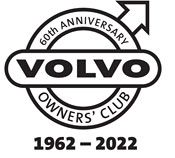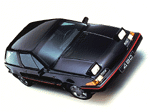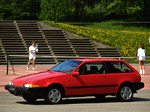

Profile on the Volvo 480
By Chris Wickers
 The 480 started life in 1978 as a
project by Volvo called the 'E12', and some 7 years later, in October 1985 it
appeared to the world as the 480 ES, with the official launch following some 6
months later at the Geneva Motor Show in March 1986. It is quite remarkable
that a Company such as Volvo could take so very long to complete the project,
particularly when they subsequently promoted it in their literature as being a
successor to the 1800, which was discontinued some 12 years earlier in 1973.
The 'E12' project was commenced in Gothenburg, and was subsequently transferred
to the Netherlands in 1983, where the cars were later manufactured. One major
advantage of manufacturing them there was that the vehicles were being built
within the European Community. The 400 series, in general, was according to
Volvo designed to complement their existing and future range, and with the
exception of the 480 (which was loosely marketed as a successor to the 1800)
was not meant as a direct replacement for either the 300 or 200 series. Despite
this statement, it is hardly surprising that the 300 series disappeared fairly
quickly after the arrival of the 440's and 460's. The 480 was a very close
competitor to the 360 GLT which probably explains why the 360 was discontinued
first. At its launch, the 480 boasted a whole host of electronic gadgets aimed
at making life easier for the driver.
The 480 started life in 1978 as a
project by Volvo called the 'E12', and some 7 years later, in October 1985 it
appeared to the world as the 480 ES, with the official launch following some 6
months later at the Geneva Motor Show in March 1986. It is quite remarkable
that a Company such as Volvo could take so very long to complete the project,
particularly when they subsequently promoted it in their literature as being a
successor to the 1800, which was discontinued some 12 years earlier in 1973.
The 'E12' project was commenced in Gothenburg, and was subsequently transferred
to the Netherlands in 1983, where the cars were later manufactured. One major
advantage of manufacturing them there was that the vehicles were being built
within the European Community. The 400 series, in general, was according to
Volvo designed to complement their existing and future range, and with the
exception of the 480 (which was loosely marketed as a successor to the 1800)
was not meant as a direct replacement for either the 300 or 200 series. Despite
this statement, it is hardly surprising that the 300 series disappeared fairly
quickly after the arrival of the 440's and 460's. The 480 was a very close
competitor to the 360 GLT which probably explains why the 360 was discontinued
first. At its launch, the 480 boasted a whole host of electronic gadgets aimed
at making life easier for the driver.
The car is equipped with an electronic information centre, displaying oil, water, and outside air temperatures, along with average speed, plus instant and average fuel consumption. Its computer also assists with the windscreen wipers, switching the rear wiper on automatically, should reverse gear be selected whilst the front wipers are on. There is also the facility whereby the front wipers increase their speed to maximum when the throttle is fully depressed for harsh acceleration. This was a very innovative feature, but one which was subsequently dropped on later models. Even the lighting has computer assistance, providing the facility of not only a delay on the interior lights, but also the option of having the front driving lights remaining on for some 20 seconds after you have got out of the car! Particularly useful if you have a dark drive!
 The one drawback to the above
benefits of this new and sophisticated technology has been the initial lack of
reliability, resulting in problems with the 'computers' and running of the
engine. I found it somewhat amusing that on querying the relatively poor idling
of mine from cold, the local dealer first checked to see if the large quantity
of modifications issued by Volvo had been carried out. To this day the 480
series (1700CC) is not noted for the smoothest of idles! With regard to the
information centre, there have been many press reports highlighting its
failure, although to date as the 400 register keeper, I am not aware of any
failures having been reported by members. It would also appear that the 2000cc
engine does not suffer from the same problem of rough idle like the 1700cc. It
would be untrue to describe the 480 as a family car, by virtue of the fact that
with four occupants there is minimal room for anything else, particularly if
the rear passengers decide to take advantage of the option of the rear seats
reclining. (it is, however, far more suited to four people than the 1800 was!)
With two people in the car, and the rear seats folded down it offers a
considerable amount of room for cases and luggage. Access to the back of the
car is made easier by the two large wide opening doors, although experience
dictates that extreme care is required to avoid tripping on the front seat
belts when getting in and out of the back bucket seats. Not only are the front
seats in keeping with the car's sporting image and looks, they are also
extremely comfortable with both front seats offering an adjustable lumbar
support, and the driver's side offering adjustable height as well.
The one drawback to the above
benefits of this new and sophisticated technology has been the initial lack of
reliability, resulting in problems with the 'computers' and running of the
engine. I found it somewhat amusing that on querying the relatively poor idling
of mine from cold, the local dealer first checked to see if the large quantity
of modifications issued by Volvo had been carried out. To this day the 480
series (1700CC) is not noted for the smoothest of idles! With regard to the
information centre, there have been many press reports highlighting its
failure, although to date as the 400 register keeper, I am not aware of any
failures having been reported by members. It would also appear that the 2000cc
engine does not suffer from the same problem of rough idle like the 1700cc. It
would be untrue to describe the 480 as a family car, by virtue of the fact that
with four occupants there is minimal room for anything else, particularly if
the rear passengers decide to take advantage of the option of the rear seats
reclining. (it is, however, far more suited to four people than the 1800 was!)
With two people in the car, and the rear seats folded down it offers a
considerable amount of room for cases and luggage. Access to the back of the
car is made easier by the two large wide opening doors, although experience
dictates that extreme care is required to avoid tripping on the front seat
belts when getting in and out of the back bucket seats. Not only are the front
seats in keeping with the car's sporting image and looks, they are also
extremely comfortable with both front seats offering an adjustable lumbar
support, and the driver's side offering adjustable height as well.
The interior is well laid out with everything easily visible, assisted by the centre console being slightly angled in the direction of the driver. The height adjustment on the steering column also assists to ensure that the best possible driving position can be obtained. The 480 was designed to be a sports car, replacing the 1800, with Volvo themselves actually using the term 'sporty' to describe it. By today's standards the car is not particularly quick, with a top speed of around 110, and the all important 0 - 60 time of approximately 10 seconds. These figures have of course been slightly improved on with the introduction of the turbo charged and 2 litre engines. The engine is surprisingly economical, with an average fuel economy of over 30 m.p.g. which will of course be reduced with harsh town driving, or increased to over 40 m.p.g. with a light right foot on a long run! In comparison to its slightly lack lustre performance in speed and acceleration terms, the roadholding and ride are excellent, being a phenomenal improvement on the 300 series. The vehicle feels as if it has a layer of glue between the road and its wheels, in even the tightest of bends. This description however only applies to good dry conditions, as I am told that in ice and snow the car needs treating with a lot more care and respect! It is an easy car to drive, offering good visibility through its all round tinted glass. It has power steering as standard, which has the useful feature of reducing the amount of assistance according to road speed. Although the styling is radically different to any other Volvo in the range, when it comes to the subject of safety, the car is still a typical Volvo, including a heavy roll bar in the roof, and steel bar protection in the side doors. The braking system consists of disc brakes on all four wheels.
Surprisingly, the 480 (and 440/460) have never been available in the USA, Volvo's biggest marketplace. Apparently it was their original intention for the to be available, but due to poor exchange rates against the dollar in the late 80's it was decided that it was not commercially viable. Throughout its short 8 year life the car has not undergone any major facelift (unlike the 700/900 series - even the 440 and 460 have had their exteriors slightly changed) The trim levels have been updated slightly both internally and externally, but that aside the car remains very similar to the original launched in 1987. Regrettably, the 480 is being discontinued with a Special Edition model being the last one produced. I am disappointed that the lilac 480 cabriolet which took centre stage at the Motorshow a few years ago never became an option in the showrooms. I somehow very much doubt if Volvo will ever produce a replacement stand alone sports car again, but will probably concentrate on the 'family' and 'executive' cars with the option of high performance variants.
Legal | Privacy | Contact Us | Search | Site Map
Volvo Owners' Club Limited® 1962-2024

